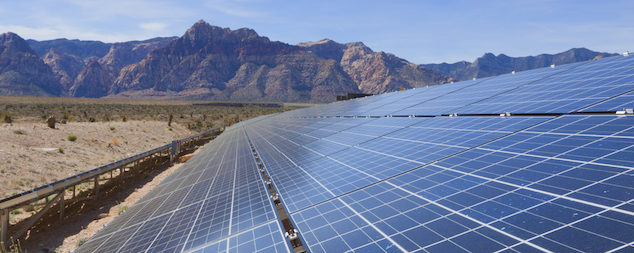Opinion
Solar power, like the sun, should belong to us all
 Solar panels arranged in California's Mojave Desert. (Photo: Andfrei Orlov, via Shuttertstock)
Solar panels arranged in California's Mojave Desert. (Photo: Andfrei Orlov, via Shuttertstock)With wildfires raging and blackouts looming, the urgent need for California’s rapid shift to a cleaner, electric grid powered by pollution-free energy is clear. Local solar power — on our roofs and in our neighborhoods — has always been a more nimble and resilient form of clean energy, but now we know that consumer solar is also cost-effective leaving little doubt that it should be a key element of the state’s energy transition.
Yet, our largest utilities and their allies are calling for a major rollback in the state’s most successful rooftop solar program – net energy metering. The state has also failed to create community solar programs to expand local solar’s reach to Californians who can’t access rooftop solar.
As the California Public Utilities Commission (CPUC) decides the future of net energy metering and the fate of our state’s energy future later this year, they ought to discard the utilities’ conventional and outdated wisdom about the costs of local solar and batteries. Instead they should pay attention to new, paradigm-shifting utility planning models that calculate both the costs and benefits local solar and battery storage brings to our energy system and ratepayers across the state.
California stands to save an average of $4 billion a year — or over $120 billion total by 2050 — simply by meeting the modest rooftop solar targets projected by the CPUC.
A new analysis, commissioned by Local Solar for All utilizing state-of-the-art utility modeling from Vibrant Clean Energy, outlines how continuing to expand local rooftop and community solar and batteries can save the state billions, while reducing greenhouse gas emissions and creating thousands of good paying jobs. Local solar and battery storage also help ease stress on the electric system during critical peak hours when power use is at its highest and reduce the need for fossil fuel plants and transmission lines.
The savings from local solar and storage are staggering.
According to the study, California stands to save an average of $4 billion a year — or over $120 billion total by 2050 — simply by meeting the modest rooftop solar targets projected by the California Energy Commission and by creating a robust community solar program. This is the equivalent of $295 in annual savings for the average California customer. The flip side of these findings are also true.
The report reveals just how costly it would be if investor-owned utilities get their way at the CPUC. Proposals submitted by the big utilities would drastically reduce the credit solar consumers receive for the excess energy they produce and add a $65-to-$90 monthly solar penalty fee to their energy bills.
In addition to the cost savings, local solar installations are also critical to advancing our state’s climate goals. By continuing to prioritize local solar and storage, the study shows that California could reduce emissions by an additional 4.1 million metric tons, leading to greater reductions in greenhouse gases versus a future that relies entirely on remote, utility-scale power plants.
As California’s economy shifts to an electrified future with ever increasing numbers of fully electrified buildings and automobiles, electricity use is anticipated to grow 20% to 80% by 2050.
Further, sustained local solar and storage growth in California would create 100,000 more jobs by 2030 and 374,000 more jobs by 2050. That’s because local solar and energy storage technologies are inherently more job-intensive, creating more well-paying jobs in local communities.
The benefits of local solar and storage can also be targeted at underserved communities and help create an energy system that is more equitable and just. Low-cost energy and bill-savings reduce the energy burden for customers who need it most and creates resiliency keeping the lights in all communities across California.
As California’s economy shifts to an electrified future with ever increasing numbers of fully electrified buildings and automobiles, electricity use is anticipated to grow 20% to 80% by 2050. It will be vastly more affordable to serve a substantial portion of that new demand with local solar and batteries than to rely solely on meeting that surge with remote power plants. This is a future we should aim for, and this analysis models what is at stake for our state and its residents.
The bottom line is that a future with significantly more local solar and storage is a brighter, cleaner, and more affordable future for California.
While utilities remain stubbornly committed to their dependence on old system planning models in an effort to defend their market-share, we urge the CPUC to review this new study before making decisions that will have far reaching impacts on the role of distributed solar and storage on California’s energy future.
Going forward, the CPUC should require utilities to use state-of-the-art modeling tools that accurately value all energy generation — not just that which they build and own.
Californians deserve a future where they can breathe clean air and keep the lights on. The sun belongs to us all, and so should solar power.
—
Editor’s Note: Bernadette Del Chiaro is the executive director of the California Solar & Storage Association. Rob Sargent is campaign director for Local Solar for All.
Want to see more stories like this? Sign up for The Roundup, the free daily newsletter about California politics from the editors of Capitol Weekly. Stay up to date on the news you need to know.
Sign up below, then look for a confirmation email in your inbox.

Leave a Reply